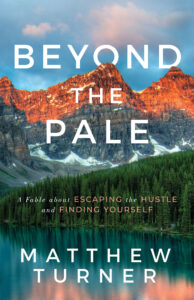In recent weeks, I’ve talked about How To Start Your Story, and how Visual Storytelling can help you in your quest to write your story. Well, considering I love transparency and honesty, and in a bid to show I practice what I preach, here’s an in-depth insight into my latest novel, I UNLOVE YOU’s humble beginnings.
If you’re a fellow pen scratcher, you know how writing a story is no easy feat. Coming up with the idea, and a few cool scenes is the simple bit, but what about the rest of it? What about developing the characters, and taking them on a journey your readers will love.
I mean, you have the beginning and the end in mind, but where the hell are the other 70,000 words coming from?!?!
[Tweet “Oh yes, writing a story is a wonderful thing indeed. But easy? HELL NO!”]
WRITING A STORY 101:
I came up with I UNLOVE YOU’s premise months before writing it. I knew there would be three main characters (I even had one of their names sorted), and could practically see chapter 1 when I closed my eyes at night. I also understood where I wanted the story to end, with a few important plot twists along the way.
However, all this accounted for maybe 5,00 words, which isn’t exactly a novel, is it?
Oh no, to write your story, you must delve deep into your mind and the writing process. Some people head straight into crafting their first draft without a care in the world, but I can’t imagine such freedom. It’s not to say I detail every single step along the way, but I need a general helping hand to guide me through the chaos.
I liken it to the great American road trip, where you know the start and finish line, and have a map to get you from A-to-B. However, if you happen to come across something epic, like the world’s largest hot dog, you take a little diversion and grab a picture or two. You think it may take three months, but if it happens to last four, who’s counting?
This is how I approach my novels, and before I begin writing a story, I like to have certain pieces in place. Below is an insight into the beginnings of I Unlove You, and the techniques I use to kick things into gear. It may or may not help you write your story, but I hope it gives you a few ideas nonetheless
PLOTTING THE JOURNEY
Like I say, I don’t suggest adding every single detail before you write your story. That’s the kind of approach an accountant would take, and writing a story and accountancy don’t quite go hand in hand. But if I woke up one day, mused-up a new story, and committed myself there and then, I’d spend the next twelve months crying.
Using SCRIVENER, I open a new project, and the first document I create is a ‘Notes Page‘.
With I Unlove You, I spent an afternoon thinking about the bits and pieces floating around my mind. My previous two novels were between 70,000 – 80,000 words, and I sensed this story fit into a similar mould. I also considered the length of each chapter, and whether they would be short and sweet or epic and long.

A RECENT SCREENSHOT OF MY ‘NOTES PAGE’ AND I UNLOVE YOU’S GENERAL OUTLINE
As you can see in the above image, I came to the conclusion that 30 chapters(ish) would do the trick. Will there be more? Or Less? I have no idea, but what this structure provides is, direction. Within a few hours, all the craziness inside my head calmed, replaced with a visual structure that guides me when to do this, and when to do that.
You may also notice my colour coding, too. Well, as all good stories, I Unlove You has a beginning, middle, and end, and by visually separating them with colour, I’m able to determine whether the beginning is too short or long, and if the big plot twists are close to one another.
In the beginning, those lines of question marks filled the majority of this page, but as time ticks, I think of new ideas, new scenes, and add them to their rightful place. It isn’t about detail at this point, and for each chapter, I write:
- Date
- Chapter Location
- Characters Involved
- BRIEF Description (feelings, conversations, the whole point of the scene)
That’s it, and YES, this does change over time, and as I tackle one edit after another, things flip and flop all over the place. But it adds clarity in the beginning, which is damn hard to come by when your mind spins with everything.

A CLOSE UP OF MY COLOUR CODED WAYS, AND HOW THIS HELPS MY TIMELINE
Plotting your journey also helps keep your timeline in check, which is easy to lose track of. This isn’t important in all stories, but for I Unlove You, the timeline is KEY. With a visual layout like this, I’m able to space things out, ensure key scenes occur at the right times, and that their build ups occur accordingly.
Of course, you could approach this in numerous ways, and I know some writer’s like to create cards and pin boards. For me, Scrivener provides everything I need under one roof, and before I know it, the crazy inside my head settles into a somewhat peaceful state. Alas, I see the light, and can begin writing a story once again 🙂
INTRODUCING AUSDYLAN, BEATRICE & JOSEPH
Once I’ve got my head around the journey, I turn my attention to the characters. When it came to creating Ausdylan, Beatrice, and Joseph, I had a hazy image of them in my mind. Well, before you write your story, you must transform this hazy picture into a crystal clear one.
Again, Scrivener makes this simple, as they have a fantastic character tool that develops clear, simple, and visual profiles. Here’s a look at Beatrice during her early days.
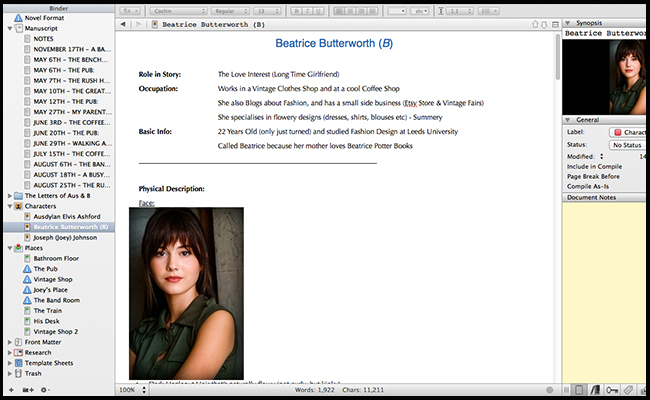
THE LOVELY BEATRICE DURING HER INCEPTION
As you can see, I use actual images of real people to help build my profiles. It’s not that Beatrice is based on Mary Elizabeth Winstead, rather, this beautiful actress matches an image I had in my head. When writing about her face and figure, I bring up Mary’s face, stare at it (which is no bad thing), and tap away as my imagination transforms what’s on screen into a clear and meaningful description.
Of course, it doesn’t stop at physical attributes, and that’s another reason I love Scrivener, because it creates headings like: Hobbies, Background, Personality, and Mannerisms – plus, you can create and add your own sections, too.
It’s these inner workings that truly matter, because before you write your story, these main characters have to transform into real people. I wrote thousands of words about Beatrice, and her mannerisms, background, personality, what makes her unique, why she worries, and who she worries about, long before starting the first draft.
As well as crafting the overall plot journey, I like to plot each individual character’s journey, too.
- Where do they begin?
- Where do they end up?
- What do they learn?
- How do they overcome what’s holding them back?
- What are the deeper meanings to their character?
- Why are they in the story, and what do they represent?
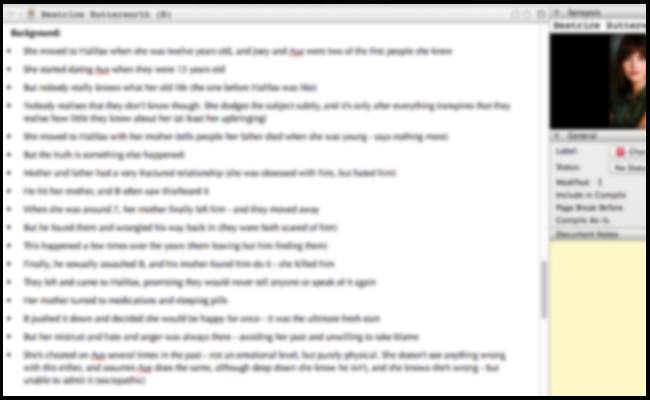
THE INNER WORKING OS BEATRICE – A LOT OF DETAIL GOES INTO THIS
Before writing a story, I try and build the most complete character profile possible. Again, this changes and evolves over time, because once I begin, ideas and feelings change. This is fine, but before you can write your story, these people have to feel real. It isn’t about finding a few pictures and writing about their face and figure.
GO DEEP. Go so deep, you write about aspects that will never appear in the story, but at the same time, define it.
Sure, you could do this after you start your story, but in my experience, this results in lots of backtracking and silly contradictions. Learn about your characters in the beginning, and let them lead the way. Because I’ll be honest with you, I went deeper during this process for TICK to the TOCK (in comparison to I Unlove You), and I feel the consequences now.
I know Aus, B & Joey well, but boy could I know them better. So, my advice? GO DEEP. REALLY DEEP!
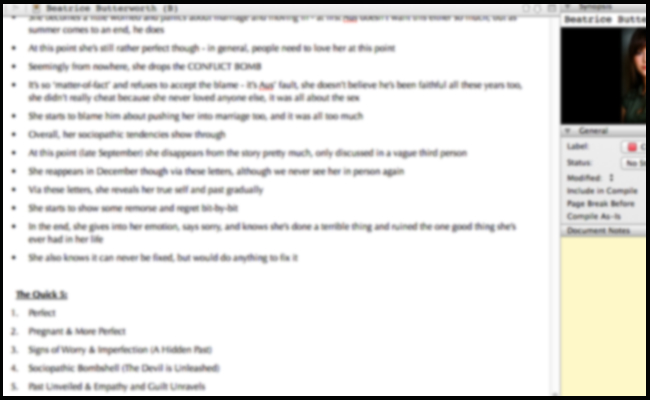
MORE DEPTH INTO B, AND THE INNER WORKINGS OF HER SOUL
SETTING THE SCENES
When it comes to writing a story, certain locations play pivotal roles. Again, more important in some stories than others (I mean, what would a Dan Brown novel be without its locations?), but every novel has one or two key settings that make or break the entire book.
In my second novel, TICK to the TOCK, location and setting played a vital part in the story. Creating over twenty Location Profiles in Scrivener, I documented the entire journey from one country to the next. Gathering pictures from places I’d never been to, and watching videos, and remembering vague memories from long ago, I built a valuable set of profiles that got me through the novel.
But here’s the thing… I did all this before starting the first draft.
The same applies for I Unlove You, and although there aren’t as many exotic and differing locations, there’s a few that pop up again and again.

A COLLECTION OF IMAGES THAT HELPED ME BUILD AN IMPORTANT SETTING IN I UNLOVE YOU
Again, I use visuals whenever possible, because they help place me in the there and then. However, I don’t just collect a bunch of images and leave it at that, because as with the characters, it goes much deeper than this.
I’m talking about smells and sounds and tastes. Rather than collect an image and call it quits, write about it. Describe what you see, and transform it into something new. This is what fiction is all about, and when writing a story, I don’t wish to document a real place, rather work my imagination into a frenzy and craft something unique.
This is what I did with the above Vintage Shop (a key setting in the story), taking something real and tinkering with it until it became my own invention. Writing about its past, and who works there, and the collection of smells and tastes and unsavoury lingers, I place myself within its made up walls. I mean, if I close my eyes right now, it’s as if I’m sat at the counter, watching a couple of hipsters finger through a rail of t-shirts.
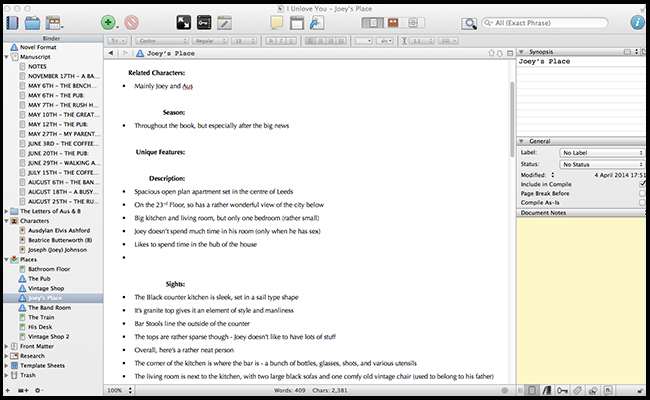
GO DEEP INTO YOUR LOCATIONS, AND GO BEYOND THE OBVIOUS
Again, I try to go DEEP. I went super deep during Tick to the Tock’s journey, and it paid off. I didn’t think it was as important for I Unlove You, and again, I live with regret. I know these locations well, but the better you know them, the better everything is further down the line.
WRITE. SHORT. STORIES!
The final piece of the puzzle before writing a story, is to write several short stories, instead.
At this stage of the process, I knew I Unlove You’s plot and journey, the characters who would partake in it, and the key locations that would host these life changing settings. Nearly ready to tackle the full novel and take on the daunting adventure, I take a final step back – and write a few short stories from each character’s POV.
I Unlove You may be told from Ausdylan’s POV, but that doesn’t mean I don’t wish to get into the mind of Beatrice or Joseph. After all, these are key individuals who play key roles, so the better I know them, the better it is for everyone, right?
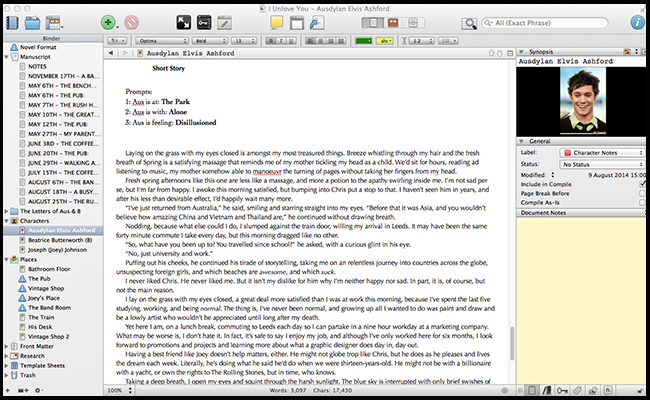
A SHORT STORY ABOUT AUSDYLAN
Sometimes I publish these stories, and sometimes I keep them to myself. But even if I don’t share them, they often lead to new ideas. For example, short stories like in the image above, lead to THE LETTER OF AUSDYLAN & BEATRICE
Oh yes, not only does writing short stories help you understand your characters, and their pain, and motivation, and the entire journey ahead, but it may just lead to new ideas and opportunities.
I did the same with my second novel, Tick to the Tock, and after writing the following short story, it lead me to a rather new and exciting idea:
[su_note note_color=”#dedede”]Ah Christmas, you’ve done it again. Your television diversions tell me all will be well and festive in the house. That a man going by the name of Claus will venture down the chimney and bring hope and joy.
Yet—like every other year—I’m alone in this house—well, of course, mother is here, but she is currently unconscious after her third—or maybe it was her fourth…hmmm, who knows, cares, or can keep count with that women—bottle of wine.
Yes, well, yes, it’s hardly festive, but I’m sure my father is out having fun. Dubai, is it? Or Sydney? Hmmm, again, who cares or can muster up the strength to check his Christmas email. He isn’t here, I know that for sure, so instead I’ll drink scotch and watch this film, which apparently goes by the name of Die Hard—although what’s so hard about dying, I wonder. It’s usually rather simple. One second you breathe, the next you don’t.
Ah well, yes, it doesn’t really matter. It is of course just another day. A 24—hour period where things occur. I personally don’t know what will happen, but maybe Dante does, or Ethan, or this Mr Claus fellow that’s supposedly paying me a visit.
Whatever may venture forward, I do enjoy the festive season. It usually means a new pair of chinos, a ghastly jumper—that’s so unusual, so vile, so unprecedented—that I love and wear with irony—or if we’re to be totally honest—not that I’ll admit it—with pure and utter jubilance.
Right, yes, so the plan. Tomorrow I will wake up and open said presents and wear them with pride and honour. I will then venture to Dante’s house, where apparently a traditional Christmas occurs. I go each year, and each year I wonder what’s so traditional about it. Nothing happens, although I suppose, in a way, that is a tradition in itself.
Then we will partake in my favourite time of the festive period: drinks at The Old Dock as old jingle jangle records play in the background. I swear, if they played music like that all year round, the Old Dock might be a pleasant place to frequent.
Ah Christmas, how I love and loathe you—although it’s unfair to say I feel either of these as you’re merely another day—but at least I get to listen to old jingle jangle records.
And then there is Sally, of course, the magical being that is she.
Her seven texts in the last four hours suggests she’s interested in some festive joy, and I suppose, yes, I suppose I should text her back. Now? No, never, not now. How can I text her now when she will be surely asleep and resting.
Then again, maybe she would like to wake up, and maybe I’ll be her knight in shining armour.
Yes, I always thought I’d make a fine knight, and tonight could be the night—no, shall be the night. In fact, I will better this texting lark and go straight to the vocal world—for words are fine, but sounds are sensual.
Now, where is my phone. Ah, there it is—there you are—there she be. “Hello? Sally, yes, hi, how are you my dear…”[/su_note]
Excuse any spelling mistakes, or the fact it may be a little pointless, but this short story provided two important benefits
- I learned a great deal about Wilbur (a key character) and his manic mind
- It motivated me to write more of these stories, which lead to ONE DAY IN SEPTEMBER
That’s right, a few short stories aimed at helping me understand my story better, lead to a series I published on Amazon – and a FREE Book that now plays an important role on this site.
So, If you want to write your story, I suggest writing a few short stories beforehand. It may or may not lead to new ideas and spin offs, but at the very least it teaches you a great deal about your characters, your settings, and overall journey. That’s what it’s all about, yes?
WRITE YOUR STORY, BABY
There you have it, an insight into how I started my latest novel.
At the time of writing this, I continue to tap away at I Unlove You’s first draft, and although I comes cross many obstacles, and have good days and bad, setting this foundation helped take this from an idea into reality.
It’s not about creating a process that dictates what you do, rather build an outline to work towards. I still have the freedom to change course, and I do all of the time. The characters evolve, too, and by the time I Unlove You hits the shelves, Ausdylan and co may not resemble how they began. This is fine, because it helps me make a start, and hope it helps you write your story, too
And as you can tell, I’m a big fan of SCRIVENER. You can achieve all of this using a word document or pen and paper, but software like the mighty Scriv makes life a great deal easier. It can be a tad tricky to get used to, so I recommend you check out their Facebook, as they link to lots of tutorials and reviews (very helpful, indeed).
Thanks for reading, and if you have any questions, please reach out to me on FACEBOOK or TWITTER. And share your own tips, too, because I’d love to know how you write your story
TURNDOG
– – – – – – – –
DID YOU ENJOY THIS POST?
If you liked this post, found value in it, and would like to be super awesome, please do the following TWO things:.
…
STEP 1: JOIN THE FREE 30 DAY BRAND STORY COURSE AND RECEIVE:
[su_row][su_column size=”2/3″]
- 14 Actionable Emails & Challenges
- 15+ Exclusive Downloads, Books & Videos
- Secret Insight into My Discover, Create & Share Technique
- One-on-One Access to ME – a Guy Who Breathes Brand Stories
- My Weekly Newsletter Packed with Insight, Giveaways & Awesome
[/su_column] [su_column size=”1/3″]
…
[/su_column][/su_row]
…


